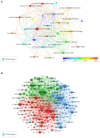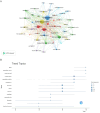Knowledge mapping of exosomes in ischemic stroke: a bibliometric analysis
- PMID: 40771978
- PMCID: PMC12325051
- DOI: 10.3389/fneur.2025.1595379
Knowledge mapping of exosomes in ischemic stroke: a bibliometric analysis
Abstract
Background: Ischemic stroke is a disease in which local ischemia and hypoxia of brain tissues are caused by obstruction of blood vessels in the brain, which in turn triggers brain tissue damage and neurological dysfunction. Recent studies have made significant progress in understanding the role of exosomes in ischemic stroke. Exosomes exhibit anti-inflammatory, immunomodulatory, anti-apoptotic, angiogenic, and neuroregenerative effects, as well as glial scar reduction and drug delivery effects in ischemic stroke. However, there is a notable gap in bibliometric analyses that focus specifically on this subject. This study systematically evaluated the current knowledge and identified emerging research trends regarding exosomes in ischemic stroke through a bibliometric analysis.
Methods: We retrieved research articles on the role of exosomes in ischemic stroke published between 2004 and 2023 from the Web of Science Core Collection (WoSCC) database and then conducted a bibliometric analysis using VOSviewer, CiteSpace, and the bibliometrix package in the R programming environment.
Results: A comprehensive analysis of 374 publications from 38 countries revealed a steady increase in research focused on exosomes in ischemic stroke. This analysis significantly emphasized the contributions of researchers from China and the United States. Key research institutions in this field include Henry Ford Health System, Henry Ford Hospital, and Shanghai Jiao Tong University. The International Journal of Molecular Sciences is the top journal in terms of publication output, and Stroke is the most frequently co-cited journal. This extensive study involved 468 authors, the most prolific of whom are Michael Chopp, Zhengbiao Zhang, and Liang Zhao, Hongqi Xin is the most frequently co-cited researcher. The primary areas of investigation are the role of endogenous exosomes in initiating and progressing ischemic stroke, as well as the potential therapeutic applications of exogenous exosomes.
Conclusion: In the context of ischemic stroke, a recent bibliometric evaluation provided a comprehensive analysis of research trends and developments related to exosomes. The findings of this study highlight current research frontiers and identify significant emerging trends. These findings offer a crucial resource for researchers focusing on exploring exosomes.
Keywords: CiteSpace; VOSviewer; bibliometrics; exosomes; ischemic stroke.
Copyright © 2025 Ding, Zou, Ma, Tang and Zhou.
Conflict of interest statement
The authors declare that the research was conducted in the absence of any commercial or financial relationships that could be construed as a potential conflict of interest.
Figures









Similar articles
-
Knowledge graph and bibliometric analysis of inflammatory indicators in ovarian cancer.Front Oncol. 2025 Jun 30;15:1533537. doi: 10.3389/fonc.2025.1533537. eCollection 2025. Front Oncol. 2025. PMID: 40661780 Free PMC article.
-
Research status, hotspots and perspectives of artificial intelligence applied to pain management: a bibliometric and visual analysis.Updates Surg. 2025 Jun 28. doi: 10.1007/s13304-025-02296-w. Online ahead of print. Updates Surg. 2025. PMID: 40580377
-
Bibliometric Analysis and Visualized Study of Research on Mesenchymal Stem Cells in Ischemic Stroke.Stem Cell Rev Rep. 2025 Jun;21(5):1283-1298. doi: 10.1007/s12015-025-10878-9. Epub 2025 Apr 21. Stem Cell Rev Rep. 2025. PMID: 40257541 Free PMC article. Review.
-
A bibliometric analysis of research trends in mesenchymal stem cell therapy for neonatal bronchopulmonary dysplasia: 2004-2024.Front Pediatr. 2025 Jun 3;13:1558301. doi: 10.3389/fped.2025.1558301. eCollection 2025. Front Pediatr. 2025. PMID: 40530182 Free PMC article. Review.
-
Research hotspots and trends in the application of diffusion tensor imaging in ischemic stroke: a bibliometric analysis (2003-2024).Front Neurol. 2025 Jun 30;16:1579598. doi: 10.3389/fneur.2025.1579598. eCollection 2025. Front Neurol. 2025. PMID: 40661241 Free PMC article.
References
LinkOut - more resources
Full Text Sources
Miscellaneous

